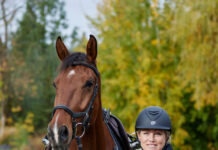Need help with Western saddle fit? Follow these five tips to ensure your horse’s Western saddle fits perfectly.
1. Tree Spread and Angle
The saddle should retain its shape once you’re mounted and for the duration of the ride.

2. Fork Height and Gullet Width
A well-fitting saddle will never make contact with your horse’s withers or spine. With your saddle set directly on your horse’s back without a pad, make sure you can place two to three vertical fingers between your horse’s withers and the fork.
Next, slide your hand down the gullet to check the clearance as far as you can reach. Visualize the gullet channel from the back of the saddle as well to confirm your horse’s spine is pressure-free from front to back.
3. Levelness
When the saddle is in the correct position, with the front edge of the tree (not the front skirt, which is flexible leather) sitting in the wither pocket behind the shoulder blade, the bottom edge of the skirt should be parallel to the ground.
A saddle that isn’t level will distribute pressure unevenly on your horse’s back, cause him discomfort, and throw off his balance. Riding in a saddle that tilts forward or back will also affect your balance and make your ride far less comfortable.

4. Centered Riding Position
A well-designed seat and correct stirrup placement will help you ride in balance with your horse. The lowest part of the seat should be centered between the fork (pommel) and cantle, so you’re sitting as close as possible to your horse’s center of gravity and where his back is strongest.
The stirrups should naturally hang vertically below your leg, making it as easy as possible to maintain correct shoulder, hip and heel alignment.
5. The Right Size for You
Your western saddle is the right seat size for you if you can place three fingers between your thigh and the swell of the saddle and a vertical hand between your seat and the cantle.
A seat that is too small will limit your ability to use your seat and legs to communicate your horse. Too large a saddle will require extra effort to consistently maintain a centered and balanced position.
DALE RUDIN is a CHA-certified riding instructor and clinician with a mindful and balanced approach to horsemanship and riding. www.un-naturalhorsemanship.com
This article originally appeared in the December 2016 issue of Horse Illustrated magazine. Click here to subscribe!






Good advise, and I can see I sure have alot more to learn….just when I thought I knew everything!! 🙂
Great information that all riders should know.
The saddle in the picture is sure well worn. Good well built.
I would also add to check the lengths of the skirts and make sure they do not extend past the 18th rib. Morgans, Arabs, and some QH lines have notoriously short backs and need special saddles.
great info
I learned some of these facts in 4-H, but learned a few new ones too.
I think I’m in a saddle that’s maybe half a size too big? I’m in a size 16″ seat, but maybe I should be in a 15.5″ seat. Do they make 15.5″????
It would good to have illustrations of a poorly fitting saddle too.
Kudos to you for talking about how our saddle must be designed in a way that keeps our horse comfortable at all times. My cousin should be mindful with this matter when he goes out and makes a purchase afterwards. He’s enrolling into a horse-riding lesson this fall and he’s required to get his own equipment.